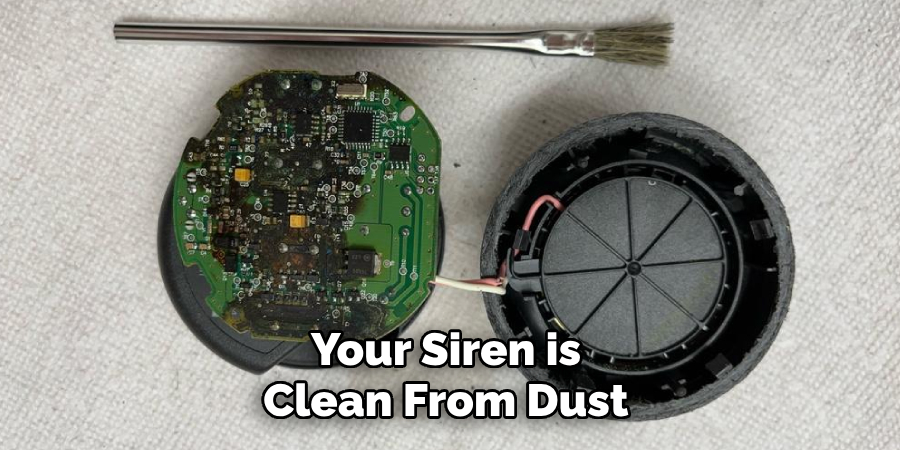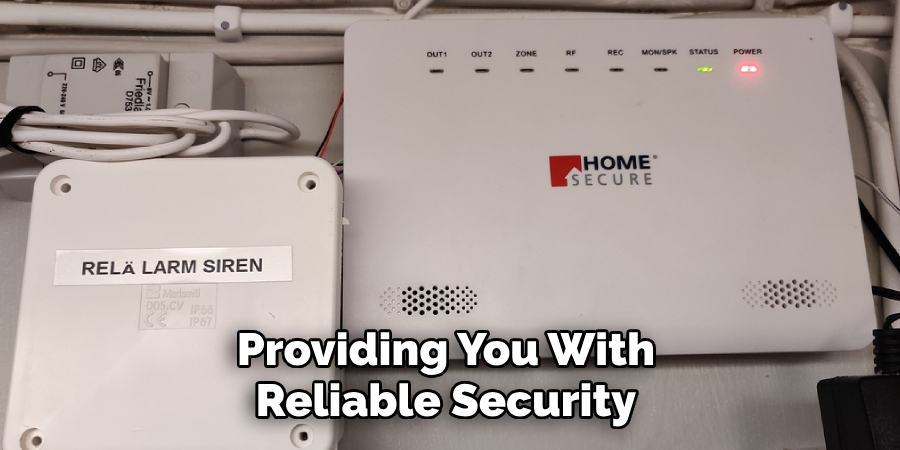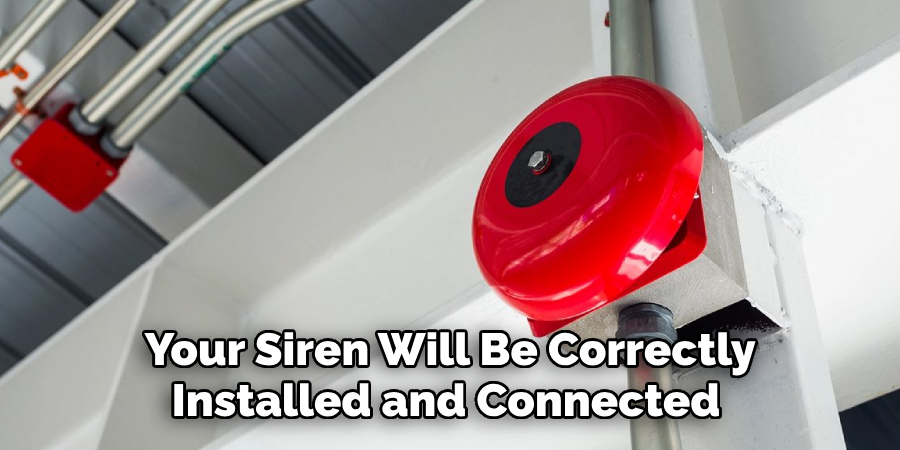Is it possible to connect your siren to an existing alarm system? Today, with the advancements in home automation technology, connecting a siren to an alarm system has never been easier.
In this blog post, we will learn how to connect siren to alarm system quickly and reliably. We will cover all the necessary components for setting up a new or improved security system that utilizes a siren and important safety tips for anyone installing their equipment.

If you want to upgrade your security setup or are just starting to create one from scratch, this guide has everything you need! Keep reading for step-by-step instructions on installing a siren in your security system successfully.
What Will You Need?
Before you can get started, you’ll need to make sure that you have the following items:
- An alarm system
- A siren
- Screwdriver and drill (optional)
- Wiring and connection components (depending on your specific setup)
Once you have all the necessary components, it’s time to get started.
8 Easy Steps on How to Connect Siren to Alarm System
Step 1: Installing the Siren
The first step is to install the siren to be heard from outside your home. You may need to drill holes into walls or use screws depending on where you want to place your siren and the type of siren you use. If you are in doubt, consult a professional to ensure proper placement and installation.
Step 2: Connecting the Siren to the Alarm System
After installing the siren, the next step is to connect it to your alarm system. First, ensure the alarm system is turned off to avoid accidental triggering or electrical issues. Then, locate the siren output terminals on your alarm panel, usually labeled as ‘siren’ or ‘alarm’.
Depending on the type of siren and alarm system, you may need to connect the siren using wires or a wireless connection. If you’re using wires, connect one wire to the positive terminal on the siren and the other to the negative terminal. The other ends of these wires should connect to the corresponding terminals on the alarm panel. Make sure your connections are secure.
If you have a wireless siren, follow the manufacturer’s instructions to pair it with your system. After completing the connection, turn your alarm system back on.

Step 3: Testing the Siren
The final step is to test the siren to ensure it’s working correctly and is properly connected to your alarm system. You can set your alarm system to test mode, following your user manual’s instructions. Once in test mode, trigger the alarm. The siren should sound loud, indicating it’s functioning as expected.
If the siren doesn’t sound, check your connections and consult your user manual or a professional for troubleshooting advice. Remember to exit test mode once you’re done.
Step 4: Fine-Tuning the System
After successfully connecting and testing your siren, the next step is fine-tuning the system to meet your specific needs. Most alarm systems allow you to adjust the siren’s volume and duration. You can also set different alarms for various triggers, such as intrusion, fire, or gas leaks.
Refer to your alarm system’s user manual for instructions on these adjustments. Remember, the goal is to have a system that effectively alerts you and your neighbors in case of emergencies while minimizing false alarms. After adjusting, test the system again to ensure the new settings work as intended.
Step 5: Regular Maintenance and Checking
Regularly checking your siren and alarm system is necessary to ensure it remains in optimal working condition. Make it a habit to test your siren at least once a month. Also, check for any loose connections; if you observe any, secure them as quickly as possible.
Ensure your siren is clean from dust or any other foreign particles that may hinder its performance. If you’re using a battery-powered siren, regularly check and replace batteries to avoid a sudden power failure. With regular maintenance, your siren will serve you efficiently for a long period.

Step 6: Understanding Your System’s Features
Once your siren is connected and your system is working as expected, take some time to familiarize yourself with all the features your alarm system offers. This includes understanding the different siren tones for various alarms and knowing how to disable the siren in case of a false alarm.
Remember, the goal is not just to install the siren but also to use the system effectively and responsibly. Reading through the user manual or consulting with a professional can provide valuable insight into utilizing your alarm system to its full potential.
Step 7: General Safety Precautions
Safety should always be your foremost priority. Turn off the alarm system before beginning any work on it to prevent accidental triggering or electrical issues. Never attempt to install the siren or any other components if you’re not confident in your abilities. Instead, seek professional help.
When testing your siren, notify your neighbors in advance to avoid causing unnecessary panic. Also, inform your alarm monitoring company, if you have one, to prevent a false alarm dispatch. Always follow the manufacturer’s instructions and guidelines when installing, maintaining, or operating the siren and alarm system.
Step 8: Professional Inspection and Maintenance
After you’ve installed your siren and connected it to your alarm system, scheduling a professional inspection’s a good idea. While DIY methods can be effective, having a professional inspect your setup can ensure that everything is working as it should be.
They can identify potential issues or inefficiencies and give you tips for maintaining your system. Regular professional maintenance can prolong the life of your siren and alarm system, providing you with reliable security for years to come.

Following these steps will have your siren connected to your alarm system in no time. With a properly installed and maintained system, you can sleep soundly at night, knowing your home is safely guarded. Regularly check and test your siren and alarm system for optimal performance!
5 Additional Tips and Tricks
- If your alarm system has multiple sirens installed, be sure to connect the siren wires in order from highest-decibel to lowest decibel. This will ensure that all alarms are triggered at the same time and volume.
- If you have an external siren connected to your alarm system, make sure that it is mounted firmly and securely so that it does not move during a break-in attempt.
- As you connect the siren wires, it is important to ensure that no frayed or exposed wires are left poking out of the wall; this can lead to short-circuiting and potentially create an undesired result when the alarm system is triggered.
- Always read the instructions with your alarm system and any associated devices to ensure that you are accurately connecting all components. Failing to follow the directions could result in a faulty connection or an ineffective alarm system.
- Ensure that your siren is functioning properly. Test it by triggering the alarm system several times to make sure that the sound travels clearly and at the right volume.
By following these simple steps, you can help ensure that your alarm system is effective and reliable when needed.
5 Things You Should Avoid
- Do not connect siren wires from highest-decibel to lowest decibel. This can cause the alarm system to malfunction and fail to alert you when needed.
- Avoid mounting external sirens in areas where they could become loose or be easily removed after installation.
- To prevent potential problems, always ensure that all exposed wire ends are securely capped off using electrical tape and plastic wire caps.
- Take care to follow the instructions carefully when connecting components of your alarm system; failing to do so may result in an ineffective or faulty connection.
- Never trigger the alarm without ensuring that it is working properly first; you don’t want to startle yourself or your family if there is a malfunction!
With these tips and tricks, you can rest assured that your siren will be correctly installed and connected to your alarm system so you can be alerted of any intrusions. Be sure to test the alarm regularly as well to ensure that it is working properly.

Conclusion
When protecting your home and family, there’s no better way than connecting Siren to your alarm system. With direct access to local law enforcement and a quick response time with the siren, you can rest assured that your home will be safe and secure.
So, if you’ve been thinking about adding a security layer to your home, take the important step today towards connecting Siren to your alarm system. You’ll be glad you did when it’s in place and helping protect what matters most – your and your family’s safety.
Hopefully, the article on how to connect siren to alarm system has helped you understand the process and learn how to do it correctly. By following all of the tips in this article, you can ensure that your connection is secure and your alarm system will be effective when needed.
About
Safety Fic is a distinguished figure in the world of Diy design, with a decade of expertise creating innovative and sustainable Diy solutions. His professional focus lies in merging traditional craftsmanship with modern manufacturing techniques, fostering designs that are both practical and environmentally conscious. As the author of diy, Safety Fic delves into the art and science of Safety Fic-making, inspiring artisans and industry professionals alike.
Education RMIT University
(Melbourne, Australia) Associate Degree in Design (Safety Fic) Focus on sustainable design, industry-driven projects, and practical craftsmanship. Gained hands-on experience with traditional and digital manufacturing tools, such as CAD and CNC software.
Nottingham Trent University
(United Kingdom) Bachelor’s in diyfastly.com and Product Design (Honors) Specialized in product design with a focus on blending creativity with production techniques. Participated in industry projects, working with companies like John Lewis and Vitsoe to gain real-world insights.
Publications and Impact
In diy, Safety Fic his insights on indoor design processes, materials, and strategies for efficient production. His writing bridges the gap between artisan knowledge and modern industry needs, making it a must-read for both budding designers and seasoned professionals.
